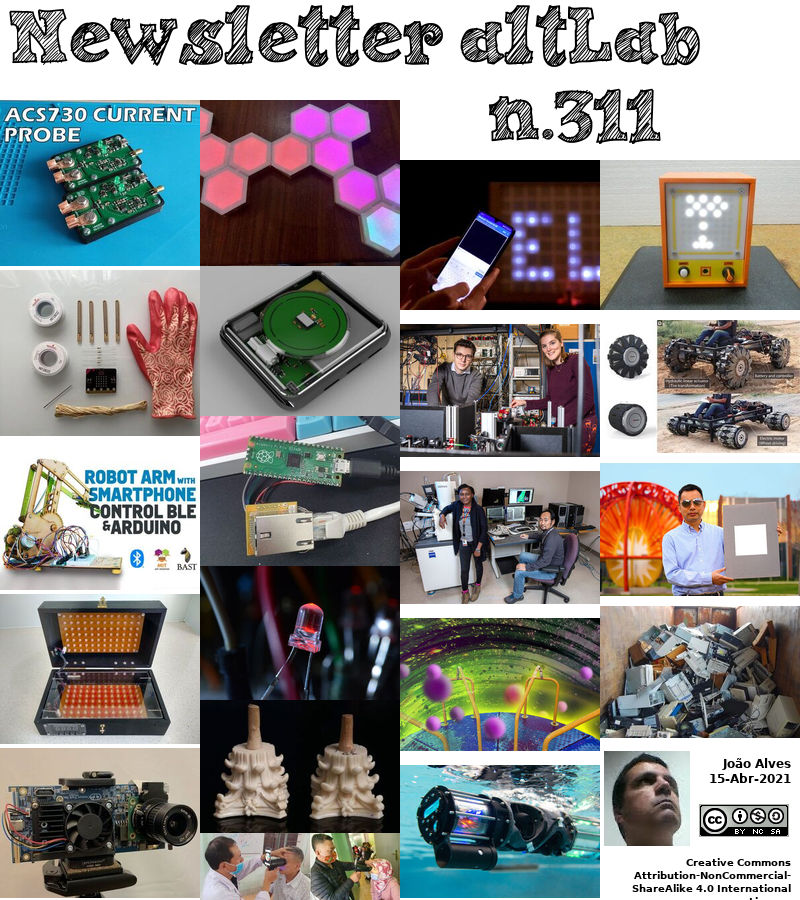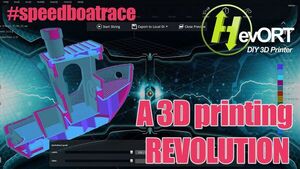2021-04-15 - Nº 311
Editorial
Esta é a Newsletter Nº 311 que se apresenta com o mesmo formato que as anteriores. Se gostar da Newsletter partilhe-a!
Todas as Newsletters encontram-se indexadas no link.
Esta Newsletter tem os seguintes tópicos:
Faz hoje anos que nascia, em 1452, o pintor, escultor, arquitecto e engenheiro italiano Leonardo da Vinci. Ele foi um grande engenheiro e inventor que projectou edifícios, pontes, canais, fortes e máquinas de guerra. Ele mantinha cadernos enormes com esboços das suas ideias. Entre eles, ele era fascinado por pássaros e voar e seus esboços incluem desenhos fantásticos como máquinas voadoras. Estes desenhos demonstram um génio para a invenção mecânica e compreensão da investigação científica, realmente séculos à frente do seu tempo. A sua fama está em ser um dos maiores pintores de todos os tempos, mais conhecido por pinturas como a Mona Lisa e A Última Ceia.
Faz também hoje anos que nascia, em 1707, o matemático e físico suíço Leonhard Euler. Ele foi um dos fundadores da matemática pura. Ele não só fez contribuições decisivas e formativas para as disciplinas de geometria, cálculo, mecânica e teoria dos números, mas também desenvolveu métodos para resolver problemas em astronomia observacional e demonstrou aplicações úteis da matemática na tecnologia. Aos 28 anos, ele cegou um olho ao olhar para o sol enquanto tentava inventar uma nova forma de medir o tempo.
Faz igualmente hoje anos que nascia, em 1874, o físico alemão Johannes Stark. Ele ganhou o Prémio Nobel de Física de 1919 pela sua descoberta em 1913 de que um campo eléctrico causaria a divisão das linhas no espectro de luz emitido por uma substância luminosa; o fenómeno é chamado de efeito Stark.
Faz também hoje anos que nascia, em 1885, o físico americano Emory Leon Chaffee. Ele é responsável pela invenção do método do tipo faísca “Chaffee Gap” para produzir oscilações eléctricas de alta frequência contínuas para transmissão de rádio foi o resultado de um trabalho de pesquisa para sua tese de doutoramento. O centelhador ficava entre as faces finais das hastes de metal (um ânodo de cobre e um cátodo de alumínio), numa atmosfera de hidrogénio húmido numa câmara selada. Ele também se especializou na área de tubos de vácuo termiônicos e medições de teste, como uma determinação directa precisa do valor de e / m, a razão da carga do electrão e sua massa. Mais tarde, ele interessou-se pelo olho, fazendo um trabalho experimental com William T. Bovie sobre a resposta eléctrica da retina, que Chaffee amplificou com um circuito de tubo a vácuo.
Faz igualmente hoje anos que nascia, em 1896, o químico russo Nikolay Nikolayevich Semyonov. Ele partilhou o Prémio Nobel de Química em 1956 com Sir Cyril Hinshelwood por "suas pesquisas sobre o mecanismo de reacções químicas". Ele foi o primeiro cientista soviético a receber o Prémio Nobel. Em 1926, com seus colegas de trabalho, Semyonov descobriu pela primeira vez as reacções de cadeia ramificada na oxidação do fósforo. Considerando que sua intenção para a investigação começou como um estudo da produção de luz daquela reacção, ele ficou surpreso ao descobrir que há uma pressão crítica de gás oxigénio abaixo da qual nenhuma actividade ocorreria. As explicações teóricas que ele desenvolveu sobre como um processo pode ser iniciado por um mecanismo em cadeia também são aplicáveis numa ampla gama de reacções químicas, incluindo oxidação, craqueamento, halogenação, polimerização e explosões. O mecanismo de cadeia cria uma avalanche de interacções.
Por fim, faz hoje anos que nascia, em 1927, o físico norte-americano Robert L. Mills. Ele partilhou o Prémio Rumford Premium em 1980 com seu colega Chen Ning Yang por seu "desenvolvimento de uma teoria de campo invariante de calibre generalizado" em 1954. Eles propuseram uma equação tensorial para o que agora são chamados de campos de Yang-Mills. O seu trabalho matemático teve como objectivo compreender a forte interacção que mantém os núcleos unidos nos núcleos atómicos. Eles construíram uma visão mais generalizada do electromagnetismo, portanto, as Equações de Maxwell podem ser derivadas como um caso especial de sua equação tensorial. A teoria Quantum Yang-Mills é agora a base da maioria da teoria das partículas elementares, e suas previsões foram testadas em muitos laboratórios experimentais.
Faz hoje anos que, em 1912, o navio R.M.S. Titanic se afundava quatro horas depois de colidir contra um icebergue. Estava na sua viagem inaugural no oceano Atlântico Norte, quatro dias fora de Southampton, Inglaterra, a caminho da cidade de Nova York, EUA. De uma estimativa de 2.224 pessoas a bordo, 1.517 morreram. Apenas 866 foram resgatados pelo Carpathia quando este chegou à área ao amanhecer. Cerca de duas em cada três pessoas morreram na água gelada. O navio carregava um número insuficiente de botes salva-vidas. O navio tinha uns impressionantes 269 metros de comprimento e tinha 28 metros de largura.
Na Newsletter desta semana apresentamos diversas noticias, artigos científicos, projetos de maker assim como alguns videos interessantes.
 João Alves ([email protected])
João Alves ([email protected])
O conteúdo da Newsletter encontra-se sob a licença  Creative Commons Attribution-NonCommercial-ShareAlike 4.0 International License.
Creative Commons Attribution-NonCommercial-ShareAlike 4.0 International License.
Outras Notícias

Monkey MindPong
"Neuralink is developing a fully-implanted, wireless, high-channel count brain-machine interface (BMI) with the goal of enabling people with paralysis to directly use their neural activity to operate computers and mobile devices with speed and ease. In a 2019 white paper, we outlined the design of our novel electrodes and our unique surgical approach, along with preliminary electrophysiology obtained in a rodent model. That generation of the Link had wired leads and a connector that protruded through the skin, and was an important platform for developing and validating our robotic surgical approach and our ultra low-power custom application-specific integrated circuits (ASICs) for amplifying and processing neural signals. In 2020, we publicly shared a wireless version of the Link that was able to stream 1,024 channels of action potentials (also called “spikes”) wirelessly and in real time (Fig. 1). We demonstrated its functionality by recording somatosensory (touch) signals in pigs exploring their environment." [...]
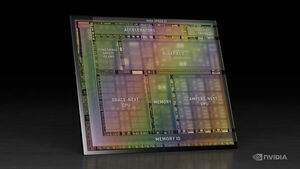
NVIDIA Unveils NVIDIA DRIVE Atlan, an AI Data Center on Wheels for Next-Gen Autonomous Vehicles
"Fusing AI and BlueField Technology on a Single Chip, New SoC Delivers More Than 1,000 TOPS and Data-Center-Grade Security to Autonomous Machines NVIDIA today revealed its next-generation AI-enabled processor for autonomous vehicles, NVIDIA DRIVE™ Atlan, which will deliver more than 1,000 trillion operations per second (TOPS) and targets automakers’ 2025 models. The NVIDIA DRIVE Atlan system-on-a-chip — the newest addition to NVIDIA’s centralized compute roadmap for autonomous vehicles — fuses AI and software with the latest in computing, networking and security for unprecedented levels of performance and security. DRIVE Atlan will include NVIDIA’s next-generation GPU architecture, new Arm CPU cores, as well as deep learning and computer vision accelerators. This data-center-like performance provides automakers ample compute capabilities to build software-defined vehicles that are richly programmable and perpetually upgradeable through secure, over-the-air updates. “The transportation industry needs a computing platform that it can rely on for decades. The software investment is too immense to repeat for each car." [...]

Samsung Introduces PixCell LED for Intelligent Headlight Systems to Enhance Road Safety
"Monolithically-integrated PixCell LED design provides precise selective lighting control to improve driving visibility and help drivers better respond to surrounding environments Samsung Electronics, a world leader in advanced digital component solutions, today announced PixCell LED, a new automotive LED module optimized for intelligent headlights, such as adaptive driving beam (ADB) systems. ADB headlamps powered by Samsung’s PixCell LEDs will help improve driver visibility and safety to enhance the overall driving experience at night and in poor weather conditions such as fog or heavy rain. “Much more than a simple automotive lighting source, Samsung’s PixCell LED is based on new lighting technology designed to improve road safety and driving convenience,” said Un Soo Kim, senior vice president of the LED Business Team at Samsung Electronics. “Beginning with PixCell LED, we will introduce tailored lighting solutions well-suited for future automobiles, including electric and autonomous vehicles.” ADB is an advanced driver assistance technology designed to help secure maximum driving visibility. In order to prevent glare to other drivers, ADB automatically adjusts headlight beam patterns when it detects any object near a moving vehicle, thereby preventing any unnecessary glare. Recent developments in future automotive technologies, such as autonomous and connected driving, have been raising the bar for vehicle safety standards and ultimately boosting demand for ADB systems." [...]
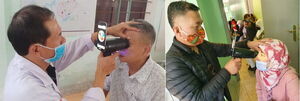
Samsung’s EYELIKE™ Fundus Camera Repurposes Galaxy Smartphones To Improve Access To Eye Care
"The Galaxy Upcycling program repurposes older smartphones into medical diagnosis cameras, helping underserved populations in Vietnam, India, Morocco and Papua New Guinea Samsung Electronics is repurposing older smartphones to enable greater access to ophthalmic health care in underserved communities around the world. Samsung partnered with the International Agency for the Prevention of Blindness (IAPB) and Yonsei University Health System (YUHS) in Korea to create medical devices1 that screen for eye disease by upcycling Galaxy smartphones that are no longer of use. This Galaxy Upcycling program is helping to address approximately 1 billion global cases of vision impairment that are preventable with proper diagnosis. According to the World Health Organization (WHO), at least 2.2 billion people have a form of vision impairment and almost half of these cases were preventable or have yet to be addressed. There is a large disparity in the prevalence of vision impairment depending on the affordability and availability of eye care services. This is estimated to be four times more common in low- and middle-income regions as compared to high-income regions.2 “People around the globe face barriers to accessing fundamental health care, and we saw an opportunity to engineer smart, innovative solutions that reuse products to drive more sustainable practices and make a positive impact in our communities,” said Sung-Koo Kim, VP of Sustainability Management Office, Mobile Communications Business at Samsung Electronics." [...]
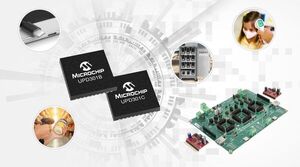
Open Source Power Delivery Software Enables Code Integration for USB System Differentiation
"With its PSF solution, Microchip is the first to offer a comprehensive programming environment and code base for Power Delivery USB Type-C with Power Delivery (PD) and open source software are two technologies leading the next wave of wired connectivity. With Microchip Technology Inc.’s (Nasdaq: MCHP) new Power Delivery Software Framework (PSF), designers can now modify and own the IP in their USB-C PD systems. By merging their proprietary code with Microchip’s fully functionable PD stack, designers have the ultimate flexibility for creating differentiated product offerings while choosing from a wide variety of Microchip SmartHubs, microcontrollers (MCUs) and standalone PD solutions for their USB systems. Microchip’s PSF solution offers both an open-source code base for power delivery and a comprehensive programming environment, removing the need for manufacturer dependence and making it easy for users to program MCUs and immediately modify PD code as their system evolves. Harnessing the benefits of this industry-changing solution, customers can now determine their own product destiny, reducing time to market and overall bill of materials (BOM). Leveraging both a software and hardware framework, developers can also choose from an expanded family of Microchip controller options to host PD functionality, including the new UPD301B and UPD301C standalone PD controllers." [...]
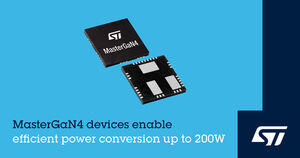
STMicroelectronics Introduces New MasterGaN4 Devices for High-Efficiency Power Conversion up to 200 Watts
"The STMicroelectronics MasterGaN4* power packages integrate two symmetrical 650V gallium nitride (GaN) power transistors with 225mΩ RDS(on), alongside optimized gate drivers and circuit protection to simplify the design of high-efficiency power-conversion applications up to 200W. The latest addition to ST’s MasterGaN family, MasterGaN4 simplifies design using wide-bandgap GaN power semiconductors by taking away the complex gate-control and circuit-layout challenges. With inputs tolerant of voltages from 3.3V to 15V, MasterGaN4 can be controlled by connecting the packages directly to Hall-effect sensors or a CMOS device such as a microcontroller, DSP, or FPGA. Leveraging the higher operating frequencies enabled by the superior switching performance of GaN transistors, as well as their increased efficiency that reduces thermal dissipation, designers can choose small magnetic components and heatsinks to build more compact and lightweight power supplies, chargers, and adapters. MasterGaN4 is ideally suited to use in symmetrical half-bridge topologies as well as soft-switching topologies such as active clamp flyback and active clamp forward. The wide supply-voltage range, from 4.75V to 9.5V, allows convenient connection to an existing power rail." [...]

Digital Isolator from STMicroelectronics Boosts Performance and Reliability Using New Thick-Oxide Galvanic Isolation Technology
"STMicroelectronics has begun volume production of the STISO621 dual-channel digital isolator, launching a new series of high-performance ICs for industrial applications and general optocoupler replacement. The STISO621 transfers data between two isolated domains at up to 100Mbit/s, with pulse distortion below 3ns, leveraging ST’s 6kV thick-oxide galvanic-isolation technology. With two independent unidirectional channels, the device performs as a UART interface handling data in both directions. Schmitt-trigger inputs to each channel ensure high noise immunity. The supply voltages to the two mutually galvanically isolated sides of the STISO621 are independent of each other. Each has a wide voltage range, allowing level translation between 3.3V and 5.5V circuitry." [...]

Renesas Strengthens RL78 Family of Low-Power MCUs with 16-Bit General-Purpose RL78/G23
"New RL78/G23 Optimized for IoT End Point Applications Expands Peripheral Functions and Security Functionality; Improves Power Consumption Renesas Electronics Corporation (TSE:6723), a premier supplier of advanced semiconductor solutions, today announced the launch and the beginning of mass production of its 16-bit general-purpose RL78/G23 microcontroller (MCU), further strengthening its RL78 Family of 8-bit and 16-bit MCUs for a broad range of applications. Compatible with Renesas' current general-purpose RL78 MCUs, such as the RL78/G13, the RL78/G23 increased the on-chip flash memory capacity to 768 KB and substantially expanded on-chip peripheral functions, which extend functionality while reducing the bill of materials (BOM) cost, while improving power consumption required by battery powered applications. With this feature combination, the new RL78/G23 is well suited for a wide range of applications that require both power and cost efficiency, including IoT endpoint devices such as home electronics, remote controls, and sensors. “It has been 10 years since we first introduced the RL78 Family, and as a leader of the extensive 16-bit MCU market, I am delighted that Renesas has continued its technology innovation drive as seen with the new RL78/G23, which delivers lower power consumption with a new process technology,” said Noriaki Nakanishi, Vice President of the MCU Device Solution Business Division at Renesas. “Moving forward, we will continue to expand the RL78 Family’s second-generation roadmap with easy to design and cost-efficient low-end MCUs to meet customers’ ever-evolving development needs.” By adopting a new process, the RL78/G23 realizes 44µA/MHz at CPU operation and 210nA during STOP (with 4KB of SRAM retention), an even lower power consumption compared to current RL78 MCUs. In addition, the newly implemented SNOOZE mode sequencer (SMS) makes it unnecessary to activate the CPU while any peripheral operations are operating in snooze mode, dramatically reducing power consumption for applications that utilize intermittent operation." [...]

FreeBSD 13.0-RELEASE Announcement
"The FreeBSD Release Engineering Team is pleased to announce the availability of FreeBSD 13.0-RELEASE. This is the first release of the stable/13 branch. Some of the highlights: - The clang, lld, and lldb utilities and compiler-rt, llvm, libunwind, and libc++ libraries have been updated to version 11.0.1. - Removed the obsolete version of the GNU debugger that was installed to /usr/libexec for use by crashinfo(8). Detailed kernel crash information can be obtained by installing modern GDB from ports or packages. - Removed the obsolete binutils 2.17 and gcc(1) 4.2.1 from the tree." [...]

Over 100 million IoT devices and servers are vulnerable because of 20-year-old TCP/IP stacks
"Security researchers at Forescout and JSOF have uncovered a set of nine vulnerabilities within four commonly used TCP/IP stacks. They estimate that more than 100 million devices are affected by these security flaws, which they dubbed "Name:Wreck." They mainly affect Internet of Things (IoT) products and IT management servers. The vulnerabilities exist in both open source and proprietary stacks, including FreeBSD and Siemens' Nucleus NET. The flaws all pertain to how these TCP/IP stacks handle DNS servers. While they found no evidence that these holes have been used in the wild, hackers could potentially utilize them to crash a network or infiltrate a victim's infrastructure allowing them remote control." [...]

Elon Musk’s Boring Company Las Vegas Loop proves quite boring in first rides – no Autopilot yet
"Elon Musk’s Boring Company has allowed the media a first look at the Las Vegas Loop, and it proved to be, well, quite boring. The Las Vegas Convention Center Loop, The Boring Company’s first full-scale loop project, has been completed, and it’s about to launch commercially. Musk’s tunneling startup completed the $50 million project in just over a year A Boring Company Loop system consists of tunnels in which Tesla autonomous electric vehicles travel at high speeds between stations to transport people within a city. While the ambition is to have complex tunnel systems underneath entire cities, the Las Vegas Convention Center Loop is only 1.5 miles long with three stops, but the hope is to eventually connect it to a larger Loop system under broader Las Vegas, especially the Strip and the airport. The consensus seems that the name is fitting, since the experience is quite boring. The vehicles are not going faster than 35 mph, and they are not being driven autonomously." [...]
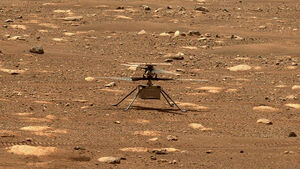
Work Progresses Toward Ingenuity’s First Flight on Mars
"The Ingenuity team has identified a software solution for the command sequence issue identified on Sol 49 (April 9) during a planned high-speed spin-up test of the helicopter’s rotors. Over the weekend, the team considered and tested multiple potential solutions to this issue, concluding that minor modification and reinstallation of Ingenuity’s flight control software is the most robust path forward. This software update will modify the process by which the two flight controllers boot up, allowing the hardware and software to safely transition to the flight state. Modifications to the flight software are being independently reviewed and validated today and tomorrow in testbeds at JPL. While the development of the new software change is straightforward, the process of validating it and completing its uplink to Ingenuity will take some time. A detailed timeline for rescheduling the high-speed spin-up test and first flight is still in process." [...]
Ciência e Tecnologia
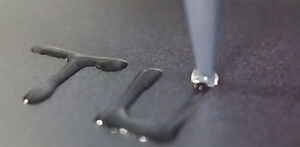
First 3D-printed Proton-conductive Membrane Paves Way for Tailored Energy Storage Devices
"The advent and increased availability of 3D printing is leading to more customizable parts at lower costs across a spectrum of applications, from wearable smart devices to autonomous vehicles. Now, a research team based at Tohoku University has 3D printed the first proton exchange membrane, a critical component of batteries, electrochemical capacitors and fuel cells. The achievement also brings the possibility of custom solid-state energy devices closer to reality, according to the researchers. The results were published on March 29 in ACS Applied Energy Materials, a journal of the American Chemical Society. "Energy storage devices whose shapes can be tailored enable entirely new possibilities for applications related, for example, to smart wearable, electronic medical devices, and electronic appliances such as drones," said Kazuyuki Iwase, paper author and assistant professor in professor Itaru Honma's group at the Institute of Multidisciplinary Research for Advanced Materials at Tohoku University. "3D printing is a technology that enables the realization of such on-demand structures."" [...]

New NASA Visualization Probes the Light-bending Dance of Binary Black Holes
"A pair of orbiting black holes millions of times the Sun’s mass perform a hypnotic pas de deux in a new NASA visualization. The movie traces how the black holes distort and redirect light emanating from the maelstrom of hot gas – called an accretion disk – that surrounds each one. Viewed from near the orbital plane, each accretion disk takes on a characteristic double-humped look. But as one passes in front of the other, the gravity of the foreground black hole transforms its partner into a rapidly changing sequence of arcs. These distortions play out as light from both disks navigates the tangled fabric of space and time near the black holes. “We’re seeing two supermassive black holes, a larger one with 200 million solar masses and a smaller companion weighing half as much,” said Jeremy Schnittman, an astrophysicist at NASA’s Goddard Space Flight Center in Greenbelt, Maryland, who created the visualization." [...]
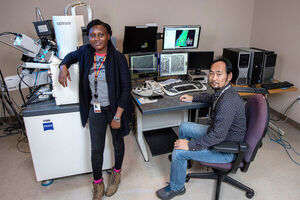
FSU engineers improve performance of high-temperature superconductor wires
"Florida State University researchers have discovered a novel way to improve the performance of electrical wires used as high-temperature superconductors (HTS), findings that have the potential to power a new generation of particle accelerators. Researchers used high-resolution scanning electron microscopy to understand how processing methods influence grains in bismuth-based superconducting wires (known as Bi-2212). Those grains form the underlying structures of high-temperature superconductors, and scientists viewing the Bi-2212 grains at the atomic scale successfully optimized their alignment in a process that makes the material more efficient in carrying a superconducting current, or supercurrent. Their work was published in the journal Superconductor Science and Technology. The researchers found that the individual grains have a long rectangular shape, with their longer side pointing along the same axis as the wire — a so-called biaxial texture. They are arranged in a circular pattern following the path of the wire, so that orientation is only apparent at very small scale." [...]
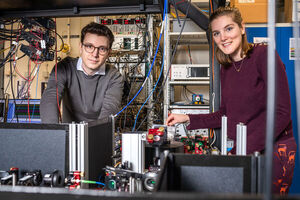
Dutch researchers establish the first entanglement-based quantum network
"A team of researchers from QuTech in the Netherlands reports realization of the first multi-node quantum network, connecting three quantum processors. In addition, they achieved a proof-of-principle demonstration of key quantum network protocols. Their findings mark an important milestone towards the future quantum internet and have now been published in Science. The quantum internet The power of the Internet is that it allows any two computers on Earth to be connected with each other, enabling applications undreamt of at the time of its creation decades ago. Today, researchers in many labs around the world are working towards first versions of a quantum internet – a network that can connect any two quantum devices, such as quantum computers or sensors, over large distances. Whereas today’s Internet distributes information in bits (that can be either 0 or 1), a future quantum internet will make use of quantum bits that can be 0 and 1 at the same time." [...]

The whitest paint is here – and it’s the coolest. Literally
"In an effort to curb global warming, Purdue University engineers have created the whitest paint yet. Coating buildings with this paint may one day cool them off enough to reduce the need for air conditioning, the researchers say. In October, the team created an ultra-white paint that pushed limits on how white paint can be. Now they’ve outdone that. The newer paint not only is whiter but also can keep surfaces cooler than the formulation that the researchers had previously demonstrated. “If you were to use this paint to cover a roof area of about 1,000 square feet, we estimate that you could get a cooling power of 10 kilowatts." [...]

Giant Electronic Conductivity Change Driven by Artificial Switch of Crystal Dimensionality
"Scientists at Tokyo Institute of Technology demonstrate the artificial control of crystal structure dimensionality to switch electronic conductivity in three orders of magnitude. The scientist succeeded to induce the direct phase transition between three dimensional and two dimensional crystal structures in a lead-tin-selenide alloy semiconductor, which shows the abrupt band structure switch from a gap-less metallic state to a semiconducting state. The present result would lead to further functional property switching in semiconductors. The electronic properties of solid materials are highly dependent on crystal structures and their dimensionalities (i.e., whether the crystals have predominantly 2D or 3D structures). As Professor Takayoshi Katase of Tokyo Institute of Technology notes, this fact has an important corollary: "If the crystal structure dimensionality can be switched reversibly in the same material, a drastic property change may be controllable." This insight led Prof. Katase and his research team at Tokyo Institute of Technology, in partnership with collaborators at Osaka University and National Institute for Materials Science, to embark on research into the possibility of switching the crystal structure dimensionality of a lead-tin-selenide alloy semiconductor." [...]
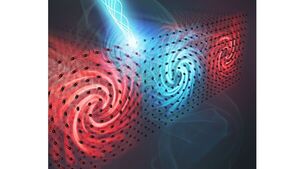
Little swirling mysteries: New research uncovers dynamics of ultrasmall, ultrafast groups of atoms
"Exploring and manipulating the behavior of polar vortices in material may lead to new technology for faster data transfer and storage. Researchers used the Advanced Photon Source at Argonne and the Linac Coherent Light Source at SLAC to learn more. Our high-speed, high-bandwidth world constantly requires new ways to process and store information. Semiconductors and magnetic materials have made up the bulk of data storage devices for decades. In recent years, however, researchers and engineers have turned to ferroelectric materials, a type of crystal that can be manipulated with electricity. In 2016, the study of ferroelectrics got more interesting with the discovery of polar vortices — essentially spiral-shaped groupings of atoms — within the structure of the material." [...]
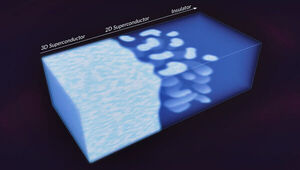
In a first, scientists watch 2D puddles of electrons spontaneously emerge in a 3D superconducting material
"It’s an example of how surprising properties can spontaneously emerge in complex materials – a phenomenon scientists hope to harness for novel technologies. Creating a two-dimensional material, just a few atoms thick, is often an arduous process requiring sophisticated equipment. So scientists were surprised to see 2D puddles emerge inside a three-dimensional superconductor – a material that allows electrons to travel with 100% efficiency and zero resistance – with no prompting. Within those puddles, superconducting electrons acted as if they were confined inside an incredibly thin, sheet-like plane, a situation that requires them to somehow cross over to another dimension, where different rules of quantum physics apply. “This is a tantalizing example of emergent behavior, which is often difficult or impossible to replicate by trying to engineer it from scratch,” said Hari Manoharan, a professor at Stanford University and investigator with the Stanford Institute for Materials and Energy Sciences (SIMES) at the Department of Energy’s SLAC National Accelerator Laboratory, who led the research. “It's as if when given the power to superconduct,” he said, “the 3D electrons choose for themselves to live in a 2D world.” The research team calls this new phenomenon "inter-dimensional superconductivity," and in a report in the Proceedings of the National Academy of Sciences today, they suggest that this is how 3D superconductors reorganize themselves just before undergoing an abrupt shift into an insulating state, where electrons are confined to their home atoms and can’t move around at all." [...]
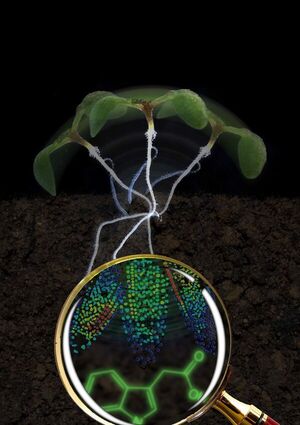
Auxin visualized for the first time
"A biosensor visualizes redistribution dynamics of the plant hormone auxin in living cells A team of scientists at the Max Planck Institute for Developmental Biology in Tübingen and the University of Bayreuth have created a novel tool that provides a real-time visualization of the growth-regulating hormone auxin in living plant cells. This new biosensor enables them to observe spatial and temporal redistribution dynamics of the plant hormone, for example in conjunction with changing environmental conditions. Auxin plays a central role in plant life. The hormone regulates various processes, from embryonic development to the formation of roots and the directional growth in response to light and gravity. Auxin binds to specific receptors in the nucleus of a cell, leading to an activation of signaling cascades that coordinate the plant's response to external stimuli. Although the molecular action of auxin is well understood mechanistically, it has not been feasible so far to directly observe auxin in individual cells." [...]

Researchers Develop New Method For Putting Quantum Correlations To The Test
"Physicists from Swansea University are part of an international research collaboration which has identified a new technique for testing the quality of quantum correlations. Quantum computers run their algorithms on large quantum systems of many parts, called qubits, by creating quantum correlations across all of them. It is important to verify that the actual computation procedures lead to quantum correlations of desired quality. However, carrying out these checks is resource-intensive as the number of tests required grows exponentially with the number of qubits involved. Researchers from the College of Science, working with colleagues from Spain and Germany, have now proposed a new technique that helps to overcome this problem by significantly reducing the number of measurements while increasing the resilience against noise. Their method offers a solution to the problem of certifying correlations in large systems and is explained in a new paper which has just been published in PRX Quantum, a prestigious journal from American Physical Society." [...]
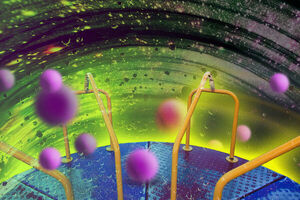
Fast-spinning black holes narrow the search for dark matter particles
"Certain ultralight bosons would be expected to put the brakes on black holes, but new results show no such slowdown. Ultralight bosons are hypothetical particles whose mass is predicted to be less than a billionth the mass of an electron. They interact relatively little with their surroundings and have thus far eluded searches to confirm their existence. If they exist, ultralight bosons such as axions would likely be a form of dark matter, the mysterious, invisible stuff that makes up 85 percent of the matter in the universe. Now, physicists at MIT’s LIGO Laboratory have searched for ultralight bosons using black holes — objects that are mind-bending orders of magnitude more massive than the particles themselves. According to the predictions of quantum theory, a black hole of a certain mass should pull in clouds of ultralight bosons, which in turn should collectively slow down a black hole’s spin." [...]

Picosecond electron transfer in peptides can help energy technologies
"Hydrogen bonds reshape peptides to move electrons a million times faster than previously known Biological energy flows, such as in photosynthesis and respiration, depend on the transfer of electrons from one molecule to another. Despite its importance to sustaining life, factors governing the rate of electron transfer, especially over long distances, are not well understood because the systems that mediate such ultrafast processes are very complex. A better understanding of electron transfer rates would help scientists improve chemical transformations, energy conversion, electronic devices, and photonic technologies. Now, an international team of researchers led by UC Riverside has observed picosecond charge transfer mediated by hydrogen bonds in peptides. A picosecond is one trillionth of a second. As short-chain analogs of proteins, crucially important building blocks of living organisms, peptides are chains of chemically linked amino acids." [...]
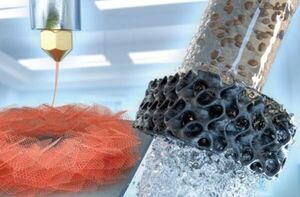
Finally, 3D-printed graphene aerogels for water treatment
"Graphene excels at removing contaminants from water, but it’s not yet a commercially viable use of the wonder material. That could be changing. In a recent study, University at Buffalo engineers report a new process of 3D printing graphene aerogels that they say overcomes two key hurdles — scalability and creating a version of the material that’s stable enough for repeated use — for water treatment. “The goal is to safely remove contaminants from water without releasing any problematic chemical residue,” says study co-author Nirupam Aich, PhD, assistant professor of environmental engineering at the UB School of Engineering and Applied Sciences. “The aerogels we’ve created hold their structure when put in water treatment systems, and they can be applied in diverse water treatment applications.” The study — “3D printed graphene-biopolymer aerogels for water contaminant removal: a proof of concept” — was published in the Emerging Investigator Series of the journal Environmental Science: Nano. Arvid Masud, PhD, a former student in Aich’s lab, is the lead author; Chi Zhou, PhD, associate professor of industrial and systems engineering at UB, is a co-author." [...]
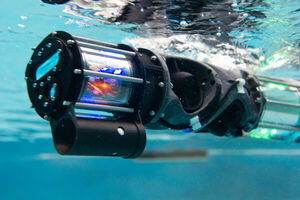
CMU's Snakebot Goes for a Swim
"Carnegie Mellon University's acclaimed snake-like robot can now slither its way underwater, allowing the modular robotics platform to inspect ships, submarines and infrastructure for damage. A team from the Biorobotics Lab in the School of Computer Science's Robotics Institute tested the Hardened Underwater Modular Robot Snake (HUMRS) last month in the university's pool, diving the robot through underwater hoops, showing off its precise and smooth swimming, and demonstrating its ease of control. "We can go places that other robots cannot," said Howie Choset, the Kavčić-Moura Professor of Computer Science. "It can snake around and squeeze into hard-to-reach underwater spaces." The project is led by Choset and Matt Travers, co-directors of the Biorobotics Lab. The submersible robot snake was developed through a grant from the Advanced Robotics for Manufacturing (ARM) Institute." [...]

3D-printed Material to Replace Ivory
"With an elephant-friendly alternative to ivory, developed by TU Wien and Cubicure, old artefacts can be restored with high precision. For centuries, ivory was often used to make art objects. But to protect elephant populations, the ivory trade was banned internationally in 1989. To restore ivory parts of old art objects, one must therefore resort to substitute materials - such as bones, shells or plastic. However, there has not been a really satisfactory solution so far. TU Wien (Vienna) and the 3D printing company Cubicure GmbH, created as a spin-off of TU Wien, have now developed a high-tech substitute in cooperation with the Archdiocese of Vienna's Department for the Care of Art and Monuments and Addison Restoration: the novel material "Digory" consists of synthetic resin and calcium phosphate particles." [...]

Sensitive qubit-based technique to accelerate search for dark matter
"Scientists at the Department of Energy’s Fermi National Accelerator Laboratory and the University of Chicago have demonstrated a new technique based on quantum technology that will advance the search for dark matter, the invisible stuff that accounts for 85% of all matter in the universe. The collaboration has developed superconducting versions of devices called qubits that will be able to detect the weak signals emitted by two kinds of hypothetical subatomic particles that could reside in an invisible but ubiquitous part of the universe called the dark sector. One is called an axion, a leading dark matter candidate. The other is called a hidden photon, a particle that possibly interacts with the photons — particles of light — of the visible universe. The technique now demonstrated by the Fermilab-University of Chicago team is 36 times more sensitive to the particles than the quantum limit, a benchmark of conventional quantum measurements, enabling searches for dark matter to proceed 1,000 times faster. Using light to detect dark particles In the technique, the qubits are designed to detect the photons that would be produced when dark matter particles interact with an electromagnetic field." [...]
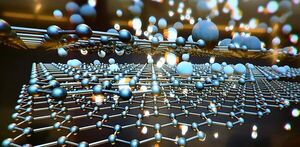
Following atoms in real time could lead to better materials design
"Researchers have used a technique similar to MRI to follow the movement of individual atoms in real time as they cluster together to form two-dimensional materials, which are a single atomic layer thick. The results, reported in the journal Physical Review Letters, could be used to design new types of materials and quantum technology devices. The researchers, from the University of Cambridge, captured the movement of the atoms at speeds that are eight orders of magnitude too fast for conventional microscopes. Two-dimensional materials, such as graphene, have the potential to improve the performance of existing and new devices, due to their unique properties, such as outstanding conductivity and strength. Two-dimensional materials have a wide range of potential applications, from bio-sensing and drug delivery to quantum information and quantum computing. However, in order for two-dimensional materials to reach their full potential, their properties need to be fine-tuned through a controlled growth process." [...]
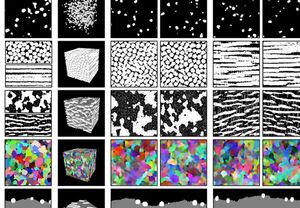
New machine learning tool converts 2D material images into 3D structures
"A new algorithm developed at Imperial College London can convert 2D images of composite materials into 3D structures. The machine learning algorithm could help materials scientists and manufacturers to study and improve the design and production of composite materials like battery electrodes and aircraft parts in 3D. Our algorithm allows researchers to take their 2D image data and generate 3D structures with all the same properties, which allows them to perform more realistic simulations. Steve Kench Dyson School of Design Engineering Using data from 2D cross-sections of composite materials, which are made by combining different materials with distinct physical and chemical properties, the algorithm can expand the dimensions of cross-sections to convert them into 3D computerised models. This allows scientists to study the different materials, or ‘phases’, of a composite and how they fit together. The tool learns what 2D cross-sections of composites look like and scales them up so their phases can be studied in a 3D space." [...]

Discovery could help lengthen lifespan of electronic devices
"Finding could result in electronics with better endurance University of Sydney researchers have made a significant discovery in the field of materials science, for the first time providing a full picture of how fatigue in ferroelectric materials occurs. Ferroelectric materials are used in many devices, including memories, capacitors, actuators and sensors. These devices are commonly used in both consumer and industrial instruments, such as computers, medical ultrasound equipment and underwater sonars. Over time, ferroelectric materials are subjected to repeated mechanical and electrical loading, leading to a progressive decrease in their functionality, ultimately resulting in failure. This process is referred to as ‘ferroelectric fatigue’. It is a main cause of the failure of a range of electronic devices, with discarded electronics a leading contributor to e-waste." [...]
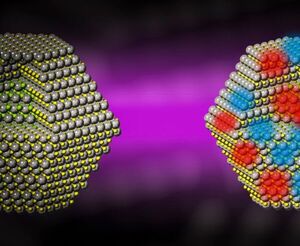
Scientists uncover a process that stands in the way of making quantum dots brighter
"The results have important implications for today’s TV and display screens and for future technologies where light takes the place of electrons and fluids. Bright semiconductor nanocrystals known as quantum dots give QLED TV screens their vibrant colors. But attempts to increase the intensity of that light generate heat instead, reducing the dots’ light-producing efficiency. A new study explains why, and the results have broad implications for developing future quantum and photonics technologies where light replaces electrons in computers and fluids in refrigerators, for example. In a QLED TV screen, dots absorb blue light and turn it into green or red. At the low energies where TV screens operate, this conversion of light from one color to another is virtually 100% efficient." [...]

Hankook's crazy transforming wheels inspired by origami waterbombs
"Hankook's R&D department has been working with biorobotics experts from Seoul National University and Harvard engineers on a weird transforming origami wheel project. These folding oddities can drastically alter their diameter and carry heavy loads. It's taken nearly a decade to get to this point, but the team has got a fully functioning set of transforming wheels built and attached them to a couple of demonstration vehicles, demonstrating that the wheels can vary their diameter from 46 to 80 cm (18.1 to 31.5 in), while supporting enough weight to put a full-size vehicle on top. The wheels are a three-layer construction based on a thick, flexible composite membrane designed to fold along similar lines to an origami waterbomb. To add structural strength and wear resistance, the non-folding panels are sandwiched with laser-cut aluminum facet panels, which hold most of the membrane rigid, with the exception of the fold lines. Left to their own devices, the wheels collapse to their minimum diameter, but squeezing them horizontally causes the wheels to fold up to their maximum diameter, where internal locking plates add extra rigidity to the structure." [...]
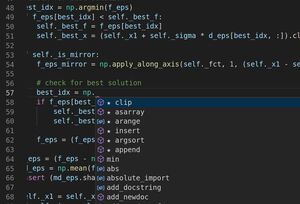
Toward deep-learning models that can reason about code more like humans
"Researchers propose a method for finding and fixing weaknesses in automated programming tools. Whatever business a company may be in, software plays an increasingly vital role, from managing inventory to interfacing with customers. Software developers, as a result, are in greater demand than ever, and that’s driving the push to automate some of the easier tasks that take up their time. Productivity tools like Eclipse and Visual Studio suggest snippets of code that developers can easily drop into their work as they write. These automated features are powered by sophisticated language models that have learned to read and write computer code after absorbing thousands of examples. But like other deep learning models trained on big datasets without explicit instructions, language models designed for code-processing have baked-in vulnerabilities." [...]

A breakthrough that enables practical semiconductor spintronics
"It may be possible in the future to use information technology where electron spin is used to process information in quantum computers. It has long been the goal of scientists to be able to use spin-based quantum information technology at room temperature. Researchers from Sweden, Finland and Japan have now constructed a semiconductor component in which information can be efficiently exchanged between electron spin and light – at room temperature and above. It is well known that electrons have a negative charge, and they also have another property, namely spin. The latter may prove instrumental in the advance of information technology. To put it simply, we can imagine the electron rotating around its own axis, similar to the way in which the Earth rotates around its own axis." [...]
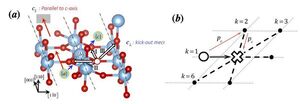
New "Quantum" Approach Helps Solve an Old Problem in Materials Science
"Scientists develop a framework based on quantum calculations to solve a long-standing problem in materials science. Real-life optimization problems are often solved using techniques that borrow concepts from quantum mechanics. In a new study, scientists from Japan apply and compare the performance of such a quantum technique with conventional methods in solving an important quantum problem in materials science, reporting a relatively slower growth in computational cost of the former, making it a potentially superior choice for problem-solving following future technological advancements. One of the most important classes of problems that all scientists and mathematicians aspire to solve, due to their relevance in both science and real life, are optimization problems. From esoteric computer science puzzles to the more realistic problems of vehicle routing, investment portfolio design, and digital marketing--at the heart of it all lies an optimization problem that needs to be solved. An appealing technique often used in solving such problems is the technique of "quantum annealing", a framework that tackles optimization problems by using "quantum tunneling"--a quantum physical phenomenon--to pick out an optimum solution out of several candidate solutions." [...]

Machine learning at speed
"Optimizing network communication accelerates training in large-scale machine-learning models. Inserting lightweight optimization code in high-speed network devices has enabled a KAUST-led collaboration to increase the speed of machine learning on parallelized computing systems five-fold. This "in-network aggregation" technology, developed with researchers and systems architects at Intel, Microsoft and the University of Washington, can provide dramatic speed improvements using readily available programmable network hardware. The fundamental benefit of artificial intelligence (AI) that gives it so much power to "understand" and interact with the world is the machine-learning step, in which the model is trained using large sets of labeled training data. The more data the AI is trained on, the better the model is likely to perform when exposed to new inputs. The recent burst of AI applications is largely due to better machine learning and the use of larger models and more diverse datasets." [...]
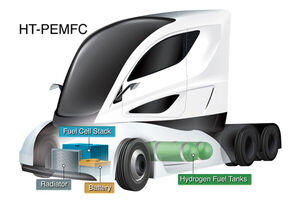
Moving toward a clean-energy future by advancing fuel cell technology
"New partnership aims to bring a viable, zero-emissions product for heavy-duty vehicles to market The U.S. transportation industry is the nation’s largest generator of greenhouse gases, accounting for nearly one-third of climate-warming emissions. To move towards a clean-energy future, developing zero-emissions technologies for heavy-duty vehicles is critical. A new partnership comprising Los Alamos National Laboratory, Advent Technology Holdings Inc., Brookhaven National Laboratory, and the National Renewable Energy Laboratory (NREL) will work over the next few years to bring to market high-temperature proton exchange membrane (HT-PEM) fuel cells that convert hydrogen and other renewable fuels into electricity. “As the heavy-duty transportation industry seeks greener alternatives to combustion engines, HT-PEM fuel cells promise a clean, efficient alternative,” said Rod Borup, Los Alamos program manager for Fuel Cells and Vehicle Technology. Traditional PEM fuel cells have a relatively low operating temperature, which makes for a low tolerance to hydrogen fuel impurities and makes waste-heat rejection a challenge for vehicles. “This project hopes to change that, as well as contribute to the acceleration of energy and heavy-duty transportation technologies that will enable a clean, zero-emissions energy future,” said Borup." [...]

A Molecule That Responds to Light
"A novel Light-Spin Interface with Europium(III) Molecule Advances Development of Quantum Computers - KIT Researchers Report in Nature Communications Light can be used to operate quantum information processing systems, e.g. quantum computers, quickly and efficiently. Researchers at Karlsruhe Institute of Technology (KIT) and Chimie ParisTech/CNRS have now significantly advanced the development of molecule-based materials suitable for use as light-addressable fundamental quantum units. As they report in the journal Nature Communications, they have demonstrated for the first time the possibility of addressing nuclear spin levels of a molecular complex of europium(III) rare-earth ions with light. (DOI: 10.1038/s41467-021-22383-x) Whether in drug development, communication, or for climate forecasts: Processing information quickly and efficiently is crucial in many areas. It is currently done using digital computers, which work with so-called bits." [...]
Projetos Maker
Diversos Projetos interessantes.
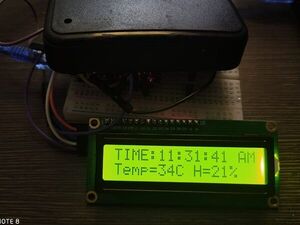
Arduino Clock (without rtc) with temperature and humidity
"This project is a arduino clock made without using an rtc and it is totally accurate it also displays the temperature and the humidity Don't mind the look of it but it works very fine I used the arduino nano as the programming board for the project You need to set the time in the code I am thinking to upgrade it with a few more things but till now I am just using a dht11 sensor with a LCD 16x2 along with an i2c module if you don't have a i2c module believe me you need to buy it saves alot of wire and effort and to me the wiring along with i2c is simple so I used it you can edit the code if you want to use normal lcd display also I used the simple DHT library which makes working with the DHT11 sensor and I changed the increase rate of seconds to 0.50 as when I finalized it with arduino nano it started moving 1 second faster idk why so for the connects I used a DHT 11 with 4 pins and here's its pinout" [...]
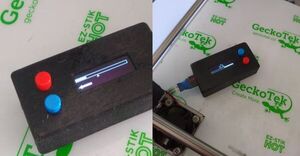
3D Printer Bed Leveler Tool
"A quick bed leveling tool for 3D printers. Around the start of the year, Dominick Lee published a project called 3D Print Bed Leveling Tool Using M5StickC on this site. After seeing it in action, I wanted one so I ordered the parts from AliExpress. Alas, after a couple of months waiting, the M5StickC didn't turn up even though the suppliers shipping details said it did. (now they want my local post office to provide proof I didn't receive it! - go figure???)." [...]
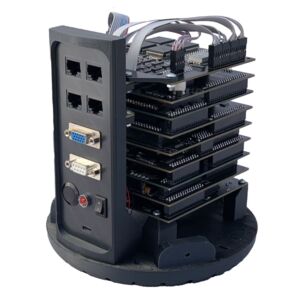
Pineapple ONE
"32 bit RISC-V homemade In this article I will describe how I designed and made a functional 32 bit RISC-V CPU at home. Specifications: "Max" clock speed: 500 kHz Program memory: 512 kB RAM size: 512 kB VGA Output: 200x150 px (black and white) 2x 8-bit Input ports 2x 8-bit output ports DETAILS Almost every electronics device uses some kind of a microcontroller nowadays. The thing is, that these chips can be very complicated, and even though you can buy them very inexpensively (like Arduino for example), I've still wanted to take a deeper look into them and understand their inner workings. I soon realised, that I have only a few options to do that: Study an existing microcontroller from a datasheet Make some kind of a emulator (C / Python) Build my own CPU from scratch You can already guess which path I took. 1. Designing my own CPU: I discovered Ben Eater's homemade CPU on Youtube and I was so mesmerised and almost immediately got to work." [...]
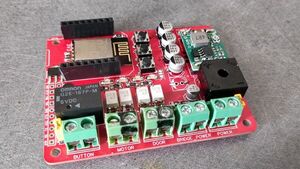
Bridging the gap between old and new, garage door gets a Wi-Fi controller
"This project started a long time ago, the idea is to be able to control the two garage doors remotly. Before anything else, you have to understand how the door is working, each door has one button, press it, it opens, press it again (in the middle) the door stops, press it again the door closes. One problem common to all version is that the original button and the rf remote need to be kept functional "just in case" 1st version The 1st version that I made was a simple Arduino with an ENC28J60 and a relay board. You could open the door by sending a UDP packet to the Arduino, and it would power the corresponding relay bridging the door button, after a while I added an authentication message that needed to be sent before sending a command. 2nd version The 1st version had a major flaw, it's freaking hard to send a UDP packet from an iPhone with a nice interface without a developer license and all. So the second version used a web interface works great except that it broke every 24h so I kind of dropped it." [...]
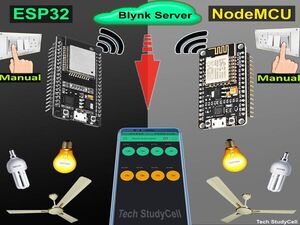
Blynk Home Automation with Multiple ESP32 & NodeMCU Network
"Make IoT-based Smart Home Automation using Multiple ESP32 & NodeMCU network to control all the home appliances from the Switches & Blynk App In this IoT project, I have shown how to make IoT-based Smart Home Automation using Multiple NodeMCU ESP32 network to control all the home appliances from the switches & Blynk App. If the internet is not available, then you can control the home appliances from manual switches. During the article, I have shown all the steps to make this smart home system. This complete Home Automation system has the following features: - Connect multiple ESP32 and NodeMCUs with the same Blynk account. - Control home appliances with WiFi (Blynk App) - Control home appliances with manual switches. - Monitor real-time feedback in the Blynk App." [...]
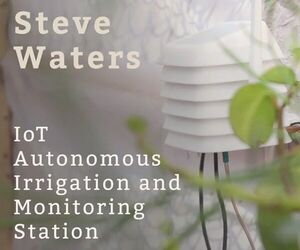
Autonomous Solar-powered Irrigation & Monitoring Station
"This instructable compiles the development and build process of my Autonomous Solar-Powered Irrigation and Monitoring Station with Stevenson Screen, named Steve Waters, which I made for my home garden. This Station gathers atmospheric data as well as soil moisture data and sends it in real time to the cloud for remote monitoring, while also autonomously controlling the irrigation via a drip-irrigation system, to keep the plants happy and within a proper humidity range. The real time data from the station can be visualized on the following link: https://thingspeak.com/channels/1281247 Origin of the project One of my main ongoing and ever-evolving projects is an urban rooftop greenhouse, which has been for me a playground and terrain for experimentation around urban farming, in which I have already implemented rain water harvesting and local waste processing, however, one of the main issues I've had is ensuring all the plants are consistently watered, as even with a single extra day without watering, many small plants quickly dry or get sunted, plus every time I went on vacation I had to arrange for someone to come and water everything. Thus, I decided to develop some sort of autonomous system to handle the irrigation, and ideally, allow me to check and manage the whole system remotely. Since I didn't have a fixed design in mind, I knew from the beginning I wanted to approach this project in a very modular and iterative fashion, so as to gradually build up and refine the systems funcions. I begun by researching all around the internet for simillar projects to gather resources and ideas which I could implement and adapt for my system, and in this process I found many simillar projects, buy mainly a few stood out particularly and ended up serving as the main inspiration and stepping stones for my desing." [...]
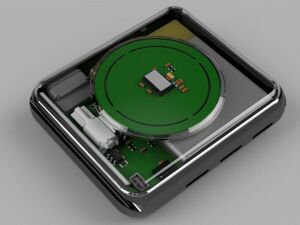
nRF53 Apple Watch
"Me, a non-apple guy, recently bought all the apple devices a man can get. Most inspiring was the apple watch, the sleek design and marvels of engineering made me think about making my own. Here is this week's project, an nRF53 version of the apple watch with some sensors I would like on my watch. Unfortinatly I dissent see this competition, untill the deadling for applying for hardware alreaddy passed. I hope that the effort going into this project is still recognized :) (PS: I want a tshirt) Makingthe ultimate wearable tech We would need all the cool features that are on the apple watch. Wireless charging, bio sensing for blood O2 levels, and EKG sensing." [...]
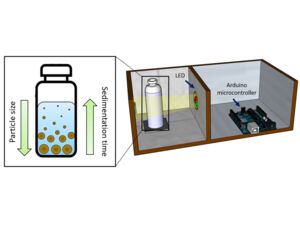
Characterisation of soil properties using a simple device
"We developed a simple, low-cost equipment for the study of soil chemistry and morphology using an arduino microcontroller. Soil is a highly complex environment, where a wide range of different processes that can influence the growth of plants take place. These processes are driven by the physical and chemical properties of the soil particles, and can be a consequence of multiple environmental factors. Thus, the characterisation of soil is often complicated, involving expensive and specialised equipment. We developed a simple and low-cost device for the physical and chemical characterisation of soil, that could help in the selection of an appropriate substrate. Among all the different factors that can have an impact on the growth of plants, we decided to focus on 3 different properties; Particle size, soil composition and presence of organic matter, and base saturation." [...]

It's About Time!
"In this age of WiFi and the Internet of Things, clocks should set themselves and be super accurate. Perhaps you’ve built an Arduino alarm clock in the past - you’ll be pleasantly surprised to see how easy it is to do this stuff with the newer Arduino processors and libraries. The same thing can be said for time displays. With I2C interfaces, 7 segment and LCD displays can be used almost effortlessly to display time and date. We will look at some examples. Background In this tutorial, I’m using the Arduino MKR WiFi 1010 processor to demonstrate how easy it is to implement super accurate clocks with equally easy to use displays." [...]
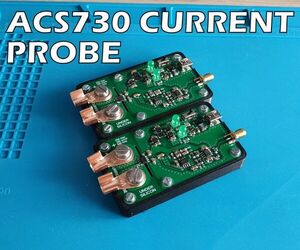
ACS730 500kHz Oscilloscope Current Probe
"If you've ever worked with some sort of power electronics or high current devices before, you may have also asked yourself how the current waveform looked in those devices, specially if you were troubleshooting them. Well, since this is not an unusual topic, there are already a number of commercial solutions. They are called current probes and allow engineers to see and measure current waveforms in an oscilloscope up to tens or hundreds of amps. Without these devices, it would be very diffficult to work in the power applications field, but they are pricey, though. In fact, the starting price for one of these has surely prevented a lot of people to do it, specially in the hobbyist scene. There are a huge variety of current probes in the market, everyone built with a different approach in mind." [...]
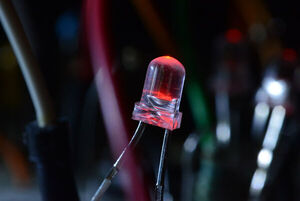
Automatic LED
"Let me tell you about my dream, of an LED that automatically adjusts its brightness to match the ambient light, without any supporting components... It's no secret that I've been working on a new and updated version of my Precision Clock (but don't get too excited, it's still months away from release). One of the improvements is to the display, which will read out to the nearest millisecond, and the entire display has been redesigned so that it won't flicker when filmed with a high-speed camera. As far as I know, there are no off-the-shelf LED display drivers that can meet my specification. Pretty much every driver these days is serially addressed, and even the fastest ones top out at around 50MHz, which isn't fast enough for my needs. There just isn't demand for LED drivers that update with sub-millisecond precision." [...]
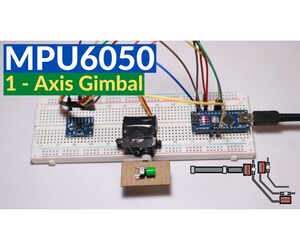
MPU6050 1-Axis Gimbal
"In this project, we will be building a "1 - Axis Gimbal with an MPU6050." After you plug your Arduino into a power source, keep the sensor on a leveled surface for a few seconds for more accurate results. Now if you move the sensor clockwise the roll values from the MPU6050 will decrease and the servo position will increase and when you move the sensor counter-clockwise the roll values from the MPU6050 will increase the servo position will decrease. This allows the servo to always stay level on the roll axis. " [...]
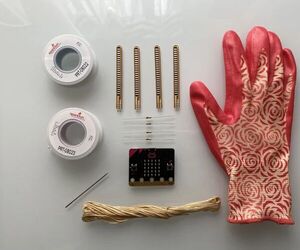
Art Glove
"The Art Glove is a wearable glove that contains different types of sensors to control art graphics through a Micro:bit and p5.js The fingers utilize bend sensors that control r,g,b values, and the accelerometer in the Micro:bit controls x,y coordinates for the graphics. I created this project as my term project for my Wearable Technology Class as a senior in the Technology, Arts, and Media program at CU Boulder. Supplies: - Gardening gloves - BBC Micro:Bit - 3-4 Flex sensors - 10K Ohm Resistors - Hook-up Wire (Red & Black) - Wire Clippers - Breadboard - Alligator clips (double sided & single sided) - Solder - Soldering Iron - Needle - Thread - Wax Paper - Tape - Scissors - Pen and Pencil" [...]

LEDs Ring Oscillator
"This is a simple ring oscillator. Each of the three transistor circuit work as an inverter and the oscillation is made possible with a feedback loop. Supplies: Parts: general purpose bipolar junction (BJT) NPN or PNP transistors - 5 (you might need spare just in case), 10 kohm resistor - 5, 100 ohm resistors - 5, 1 kohm resistors - 5, 470 uF capacitors - 4, matrix board - 1 (10 cm by 10 cm), insulated wires. Tools: pliers, wire stripper. Optional parts: solder, heat sinks, heat transfer paste. Optional tools: soldering iron." [...]

Cardboard MIDI Drum Pad
"My sister and I were talking a bit ago and she said she wanted a drum. The problem is she's in college! Roommates are not going to appreciate that. I looked for options online, but found nothing. All sorts of MIDI pads existed, but only a few had velocity sensitive drum pads and none of those were easy to follow. This is an attempt to recreate the path I followed to make it with my older brother." [...]

NanoCrief
"After seeing the Nanoleaf Aurora LED panels on the internet, I decided to create my own version so that it could be easily recreated by everyone. Supplies: To realize them, you will need: Cardboard Vinavil (or any other type of cardboard glue) Cutter (or a pair of scissors) Led strip RGB White paper Biodegradable dishes (optional)" [...]

Simple Lux Meter (Light Intensity Meter) Based on BH1750, Arduino and Oled Screen
"In this short Instructable I show you how I made a light intensity meter based on a BH1750 sensor module. This BH1750 has a I2C bus to communicate with the arduino pro mini I used. The Oled screen also used the I2C bus. I use a 3.3V arduino since I power it with a LiPo battery. Supplies: Arduino IDE and BH1750 library BH1750 module Arduino pro mini 328P 3.3V Lipo battery TP4056 charger module Switch Enclosure 0.91 inch Oled screen 10K and 20K resistor" [...]
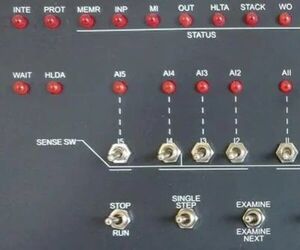
Altair 8800 Arduino Emulator With a Virtual Front Panel
"This instructable is the steps to setup and run an Altair 8800 emulator that runs on an Arduino Mega 2560 or an Arduino Due. Connect your computer to the Arduino Mega or Due. No other components required. No other wiring required. Download the emulator program files. From your Arduino IDE, click Run to compile and upload the emulator." [...]
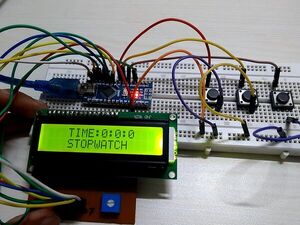
Make Your Own Stopwatch With Arduino
"By using an Arduino board, switches and an LCD display create a simple stopwatch This project is about how to make a stopwatch using Arduino Nano and an LCD. Its a fun project to learn how to use an LCD with Arduino. If you want to learn how the Arduino takes in input from devices then you might want to try this project. The stopwatch performs three basic functions i.e start, pause/stop, reset and it can count up to 23:59:59. First connect one terminal of the switch to the digital I/O pins of the Nano and the other terminal (diagonal terminal) to +5V. (You can connect the other terminal to GND depending on the type of switch you are using." [...]

Lane Tech HS - Stepper Motor Spinning Spool Project
"I wanted to create a device that could spin spools of thread when I pressed a button so I could just cut the thread and continue sewing. Context I am a person who avidly pursues art projects and crafts, and among my many endeavors is embroidery and sewing. It's a bit cumbersome to look through a bin to find the color of thread I want at a given moment, so I decided to make a device that would let me easily get the thread I need. Objective The goal of this project was to make a device that would spin spools of thread with the push of button. Then I would be able to simply tug on whichever thread I want and cut the desired amount. To achieve this, I use the particle argon, a stepper driver module, a stepper motor, my phone, and the Blynk IoT platform." [...]
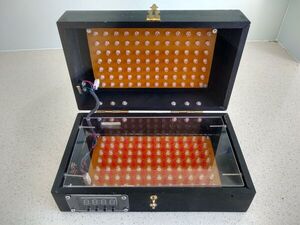
UV Exposure Box
"A UV Exposure Box to expose photoresist or solder masks for single and double boards. Most of the projects that I build have a custom printed circuit board. With a preference to making my own PCBs rather than use proto-boards, the minimum track width is usually limited by the method used to make the board. With the Toner method, minimum track width is about 0.016in. To get smaller tracks than this, photographic methods are better suited. There are a number of tutorials on how to create a board using the photoresist method so I won't cover it here." [...]
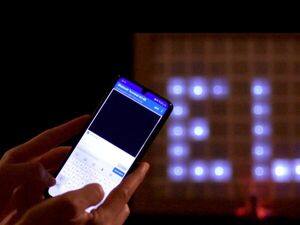
Bluetooth controlled LED matrix
"A Hand-crafted 8x8 LED matrix driven on Arduino using the MCP23017 GPIO expander and controlled via Bluetooth from an Android device. The internet is littered with tutorials teaching how to use dot matrices or build them, so why add-in another one I hear you say? Simply because making LED displays is fun, the outcome is eye-pleasing and useful in every way you could imagine. And since we’re at the age of IoT, what a better way to interact with it than from your smartphone. I used the LED matrix I built as a scrolling ticker, just to showcase the versatility of such a device. In the following I’ll shed some light on the essential building blocks of this project." [...]
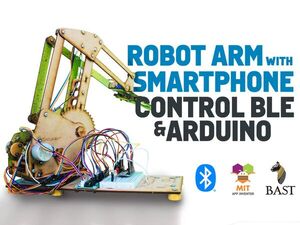
Robot Arm with Smartphone Control BLE and Arduino
"Are you thinking about make an Android app for arm robot with BLE? With this project you can understand how to work BLE and control it. ARM Robot This type of robotic arm has been selected for its simplicity and you can find it in some open publications. This type of robot has 3 degrees of freedom and 1 axis of action or work. Each of its joints works using a stepper motor, so it is a good practice to learn to control this type of motor using any of the commercial controllers, later on, I will tell you which one is used in this practice. The Bast BLE is the new Feather family member with Bluetooth Low Energy in my projects because it is open-source, has native USB support featuring the nRF52840!" [...]
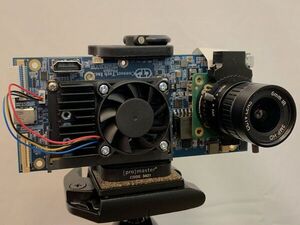
MaskCam: A Jetson Nano AIoT Mask Detection Camera
"MaskCam is a smart mask detection camera based around the Jetson Nano that features 30FPS video processing and web server connectivity. MaskCam is a prototype reference design for a Jetson Nano-based smart camera system that measures crowd face mask usage in real-time, with all AI computation performed at the edge. MaskCam detects and tracks people in its field of view and determines whether they are wearing a mask via an object detection, tracking, and voting algorithm. It uploads detection statistics to the cloud, where a web GUI can be used to monitor face mask compliance in the area the camera is watching. It saves interesting video snippets to local disk (e.g., a sudden influx of lots of people not wearing masks) and can optionally stream video via RTSP. We urge you to try it out!" [...]
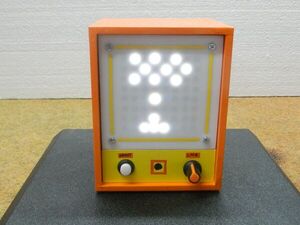
Space Invaders Game on 8x8 Homemade LED Matrix
"The goal is to defeat wave after wave of descending aliens with a horizontally moving laser to earn as many points as possible. Space Invaders is a 1978 arcade game created by Tomohiro Nishikado. The goal is to defeat wave after wave of descending aliens with a horizontally moving laser to earn as many points as possible. On the given video I will show you how to make a Space Invaders game on a homemade 8x8 Led Matrix. The device is very simple to build and contains only a few components: - Arduino Nano microcontroller - 8x8 Led matrix - 10 Kiloohms Potentiometer - Buzzer - and Momentary switch" [...]

Simple Weather Station
"Using DHT11 sensor, an OLED display and Arduino Uno R3 You can make your own little weather station. " [...]
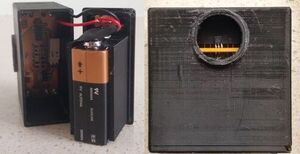
Electronic Depth Gauge for Dremel Drill Press
"A clip-on electronic depth gauge for a Dremel Drill Press. No wires or screws required. Sometimes during a build, you may need to drill holes of a fixed depth. I have a Dremel Drill Press and while it is a useful tool, the "depth gauge" that is incorporated is sometimes problematic. The problem is that over time either due to vibrations or hitting the stop, it will move making the subsequent holes deeper than the first hole drilled. After reading Thomas Angielsky's Drill Depth Display with Gyro Sensor build, I wondered how I might make something like it for my Dremel Drill Press." [...]
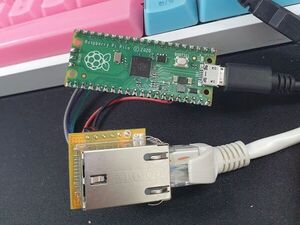
How to add W5500 Ethernet to Raspberry Pi Pico (Python) - 1
"HOWTO: Raspberry Pi Pico + WIZnet W5500 Ethernet + CircuitPython - Manual IP setting & Ping Demo" [...]
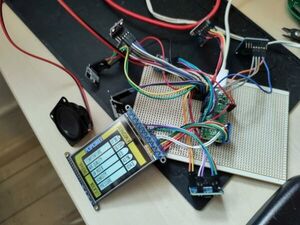
The PicoPicorder Project
"If you’ve been reading this blog for a long time, you’ll know that my first Raspberry Pi project was a version of a Star Trek Tricorder. The first version was made out of LEGO and used a Pi in combination with an Arduino Leonardo clone. It was rather large, it didn’t do a LOT but I liked it and it taught me so much. It also started my unhealthy obsession with sensors! Flash forward nine years from the original conception (!). I have since moved on with the project to using more sensors, better enclosures and exploring battery power." [...]

ThimbleKrox - Mouse Control with Your Fingers
"A thimble which, thanks to a GY-521 and an Arduino Leonardo, is able to control the mouse pointer. Hello everyone, here is my first project, ThimbleKrox that is a thimble that allows you to control the mouse pointer through the movement of the index (or any finger). Step 1: Materials and tools needed Materials needed: Arduino Micro MPU-6050 a cable to connect the Arduino and the PC (micro USB to USB) Jumper (to connect the Arduino and the MPU-6050) an elastic (if you want to attach the Arduino to your hand) Tools needed: a computer with the Arduino IDE installed (to boot the code in the Arduino) Soldering iron (only if the Arduino does not have the pins connectors pre-assembled) 3D printer (if you want your thimble to look cool)" [...]

IoT | Telegram Fingerprint Door Lock and Surveillance Camera
"Via Telegram, get apprised of every attempt to lock or unlock the door w/ surveillance footage by 5MP night vision camera or USB webcam. For a long time, I had been contemplating installing a security system for my balcony garden door with ample features to grant permission to lock or unlock the door to anyone but me. Thus, I decided to create this project that suffices my balcony garden seclusion with a fingerprint sensor and lets me check its status by sending me surveillance footage by a night vision camera or a USB webcam. Since Telegram is a cross-platform cloud-based messaging service compatible with iOS and Android, I decided to create a Telegram bot to manage my security system on disparate devices easily. In Telegram, it is effortless to create bots with a command list unalike any other messaging application, which are special accounts that do not require an additional phone number to set up. IoT Surveillance System, the Telegram bot I created for this project, allows me to change the camera type option, request surveillance footage, and display the entry log with these commands: enable_night_vision disable_night_vision status_check last_access entry_log To fetch and transfer data via the Telegram bot, I developed a PHP web application (outgoing) that gets updated from the Telegram Bot API, sends surveillance footage to the bot, and saves information to the database." [...]
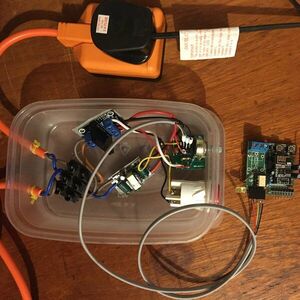
WiFive55
"Enhanced ESP-01 WiFi relay/SSR/opto module & 555 emulator. Yet another ESP-01 relay board but better: Does not glitch on boot! Breadboard friendly. In-situ programming. On-board buttons. Choice of outputs (GPIO, mechanical relay, PCB SSR, Fotek SSR, MOSFET, opto-isolated DC push-pull)." [...]
Secção Videos
Videos interessantes.
That's all Folks!



